Case Study: Potential and Limitations of Renewable Energy in Oman
VerifiedAdded on 2022/10/10
|20
|5393
|348
Report
AI Summary
This report provides an in-depth analysis of renewable energy sources in Oman, specifically focusing on tidal and biomass energy. It begins with an executive summary highlighting the need for sustainable energy solutions in Oman due to depleting non-renewable resources. The report then delves into the potential of tidal and biomass energy, evaluating their technologies, energy production capacities, and environmental impacts. It identifies issues related to renewable energy implementation, such as the intermittency of sources and initial high infrastructure costs, while also highlighting the benefits including reduced pollution and climate change mitigation. The study examines the importance of biomass management and suggests potential solutions for biomass energy utilization. The report also evaluates current renewable energy technologies and discusses the importance of diversification in energy sources, taking into account site allocations. Finally, the report provides recommendations and conclusions, emphasizing the need for Oman to embrace renewable energy to meet its growing energy demands and reduce its reliance on fossil fuels. The report also highlights the economic benefits of renewable energy, such as cost savings and job creation, and discusses the role of government policies and incentives in promoting the adoption of renewable energy technologies. The report concludes by emphasizing the potential for Oman to become a leader in renewable energy and contribute to global sustainability.
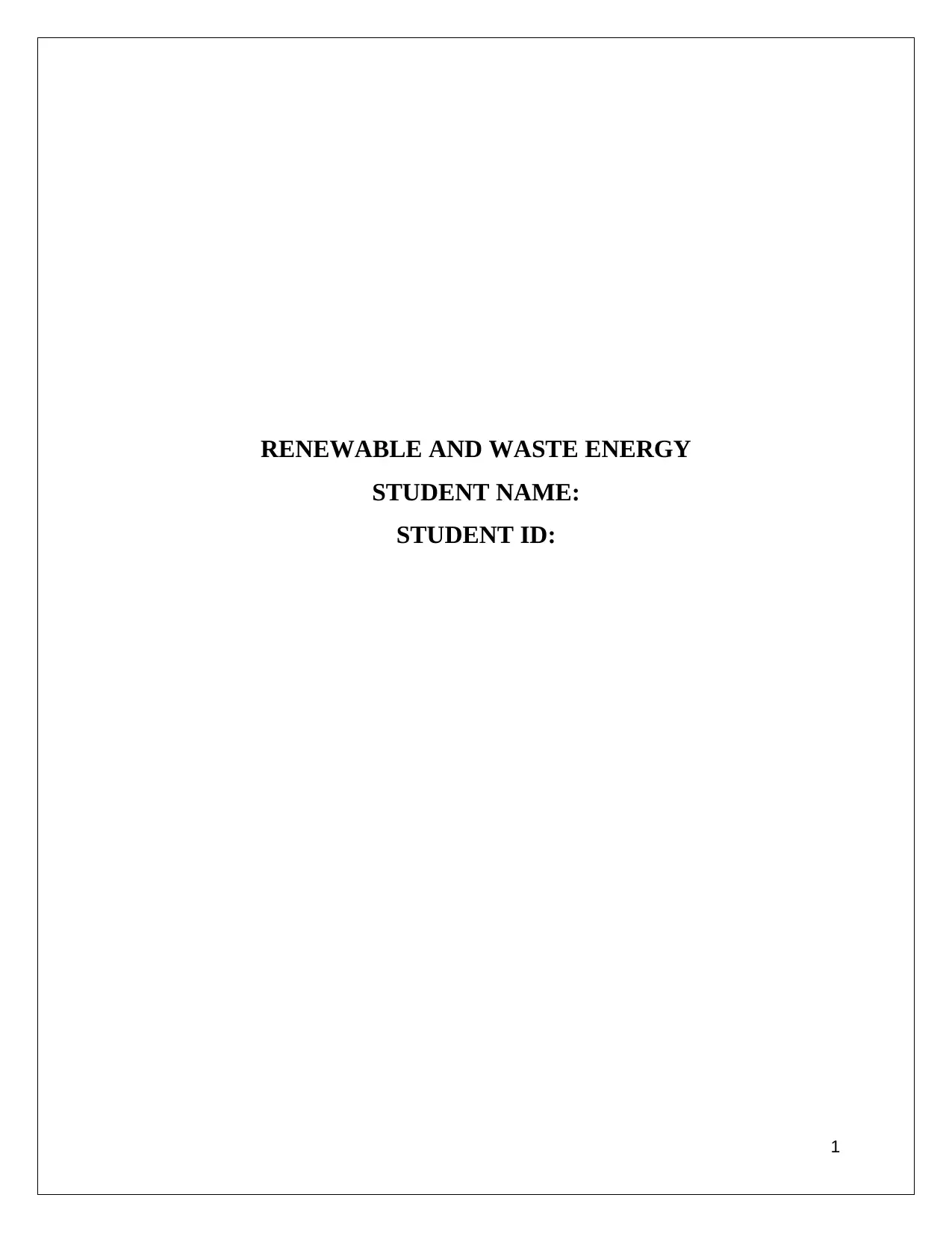
RENEWABLE AND WASTE ENERGY
STUDENT NAME:
STUDENT ID:
1
STUDENT NAME:
STUDENT ID:
1
Paraphrase This Document
Need a fresh take? Get an instant paraphrase of this document with our AI Paraphraser
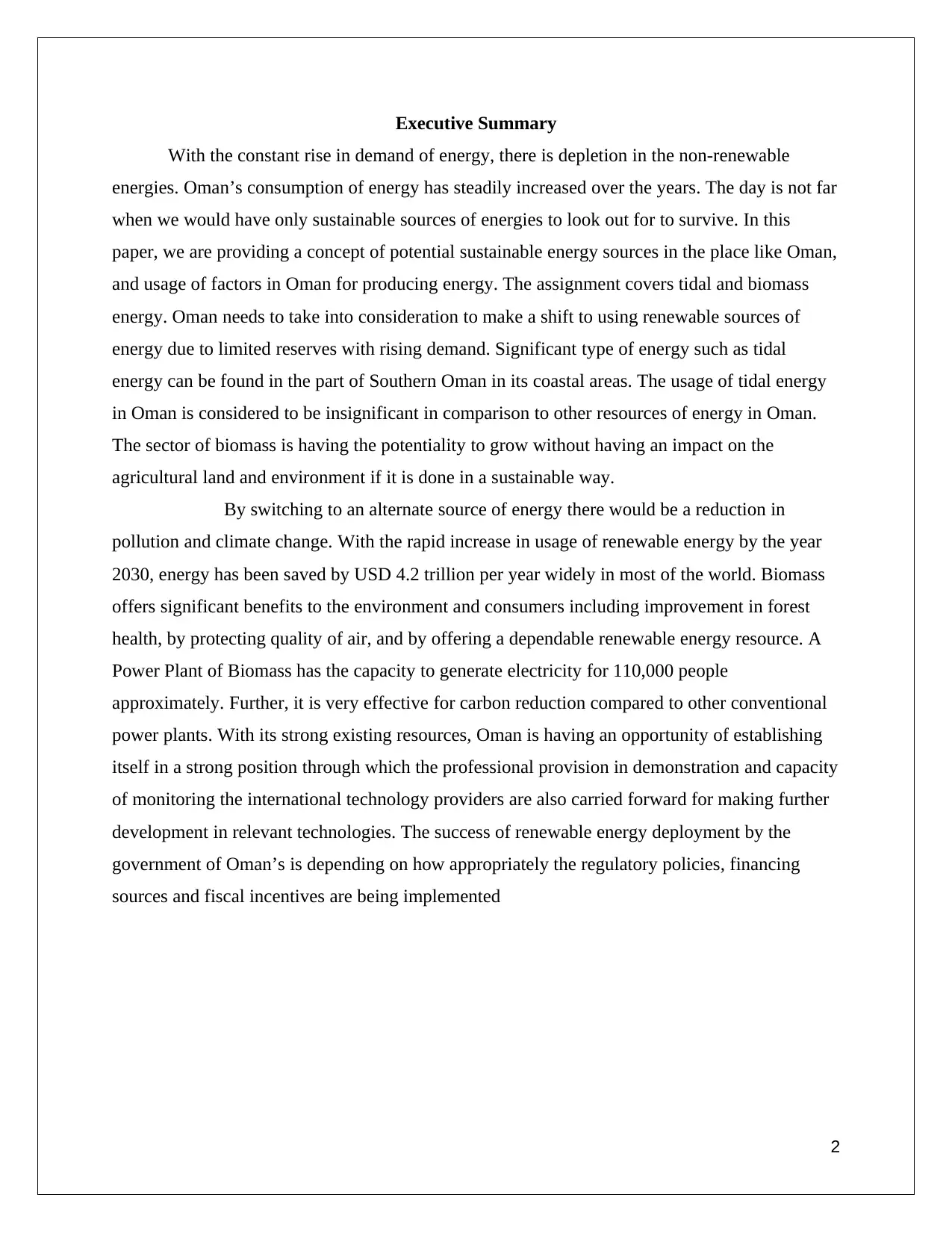
Executive Summary
With the constant rise in demand of energy, there is depletion in the non-renewable
energies. Oman’s consumption of energy has steadily increased over the years. The day is not far
when we would have only sustainable sources of energies to look out for to survive. In this
paper, we are providing a concept of potential sustainable energy sources in the place like Oman,
and usage of factors in Oman for producing energy. The assignment covers tidal and biomass
energy. Oman needs to take into consideration to make a shift to using renewable sources of
energy due to limited reserves with rising demand. Significant type of energy such as tidal
energy can be found in the part of Southern Oman in its coastal areas. The usage of tidal energy
in Oman is considered to be insignificant in comparison to other resources of energy in Oman.
The sector of biomass is having the potentiality to grow without having an impact on the
agricultural land and environment if it is done in a sustainable way.
By switching to an alternate source of energy there would be a reduction in
pollution and climate change. With the rapid increase in usage of renewable energy by the year
2030, energy has been saved by USD 4.2 trillion per year widely in most of the world. Biomass
offers significant benefits to the environment and consumers including improvement in forest
health, by protecting quality of air, and by offering a dependable renewable energy resource. A
Power Plant of Biomass has the capacity to generate electricity for 110,000 people
approximately. Further, it is very effective for carbon reduction compared to other conventional
power plants. With its strong existing resources, Oman is having an opportunity of establishing
itself in a strong position through which the professional provision in demonstration and capacity
of monitoring the international technology providers are also carried forward for making further
development in relevant technologies. The success of renewable energy deployment by the
government of Oman’s is depending on how appropriately the regulatory policies, financing
sources and fiscal incentives are being implemented
2
With the constant rise in demand of energy, there is depletion in the non-renewable
energies. Oman’s consumption of energy has steadily increased over the years. The day is not far
when we would have only sustainable sources of energies to look out for to survive. In this
paper, we are providing a concept of potential sustainable energy sources in the place like Oman,
and usage of factors in Oman for producing energy. The assignment covers tidal and biomass
energy. Oman needs to take into consideration to make a shift to using renewable sources of
energy due to limited reserves with rising demand. Significant type of energy such as tidal
energy can be found in the part of Southern Oman in its coastal areas. The usage of tidal energy
in Oman is considered to be insignificant in comparison to other resources of energy in Oman.
The sector of biomass is having the potentiality to grow without having an impact on the
agricultural land and environment if it is done in a sustainable way.
By switching to an alternate source of energy there would be a reduction in
pollution and climate change. With the rapid increase in usage of renewable energy by the year
2030, energy has been saved by USD 4.2 trillion per year widely in most of the world. Biomass
offers significant benefits to the environment and consumers including improvement in forest
health, by protecting quality of air, and by offering a dependable renewable energy resource. A
Power Plant of Biomass has the capacity to generate electricity for 110,000 people
approximately. Further, it is very effective for carbon reduction compared to other conventional
power plants. With its strong existing resources, Oman is having an opportunity of establishing
itself in a strong position through which the professional provision in demonstration and capacity
of monitoring the international technology providers are also carried forward for making further
development in relevant technologies. The success of renewable energy deployment by the
government of Oman’s is depending on how appropriately the regulatory policies, financing
sources and fiscal incentives are being implemented
2
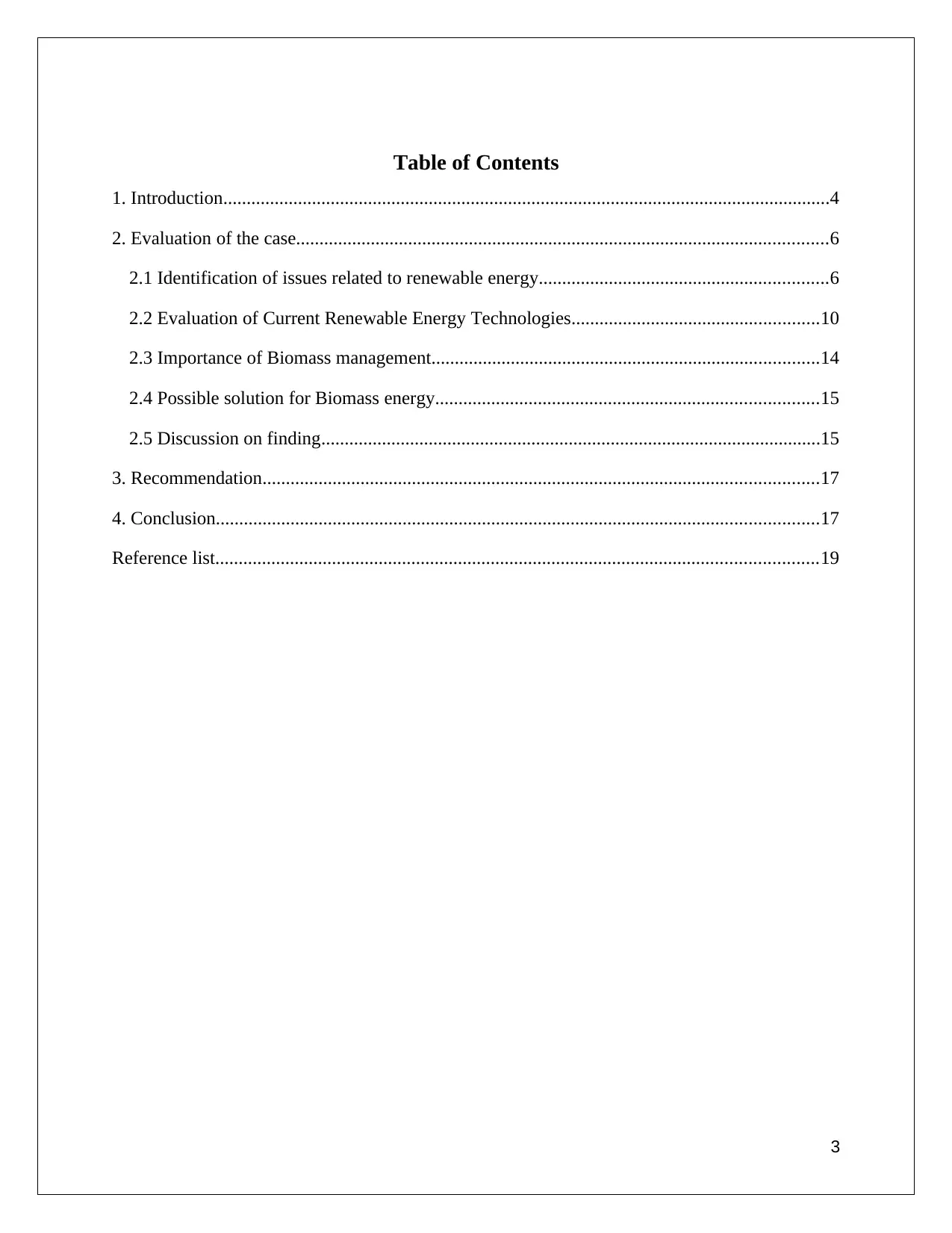
Table of Contents
1. Introduction..................................................................................................................................4
2. Evaluation of the case..................................................................................................................6
2.1 Identification of issues related to renewable energy..............................................................6
2.2 Evaluation of Current Renewable Energy Technologies.....................................................10
2.3 Importance of Biomass management...................................................................................14
2.4 Possible solution for Biomass energy..................................................................................15
2.5 Discussion on finding...........................................................................................................15
3. Recommendation.......................................................................................................................17
4. Conclusion.................................................................................................................................17
Reference list.................................................................................................................................19
3
1. Introduction..................................................................................................................................4
2. Evaluation of the case..................................................................................................................6
2.1 Identification of issues related to renewable energy..............................................................6
2.2 Evaluation of Current Renewable Energy Technologies.....................................................10
2.3 Importance of Biomass management...................................................................................14
2.4 Possible solution for Biomass energy..................................................................................15
2.5 Discussion on finding...........................................................................................................15
3. Recommendation.......................................................................................................................17
4. Conclusion.................................................................................................................................17
Reference list.................................................................................................................................19
3
⊘ This is a preview!⊘
Do you want full access?
Subscribe today to unlock all pages.

Trusted by 1+ million students worldwide
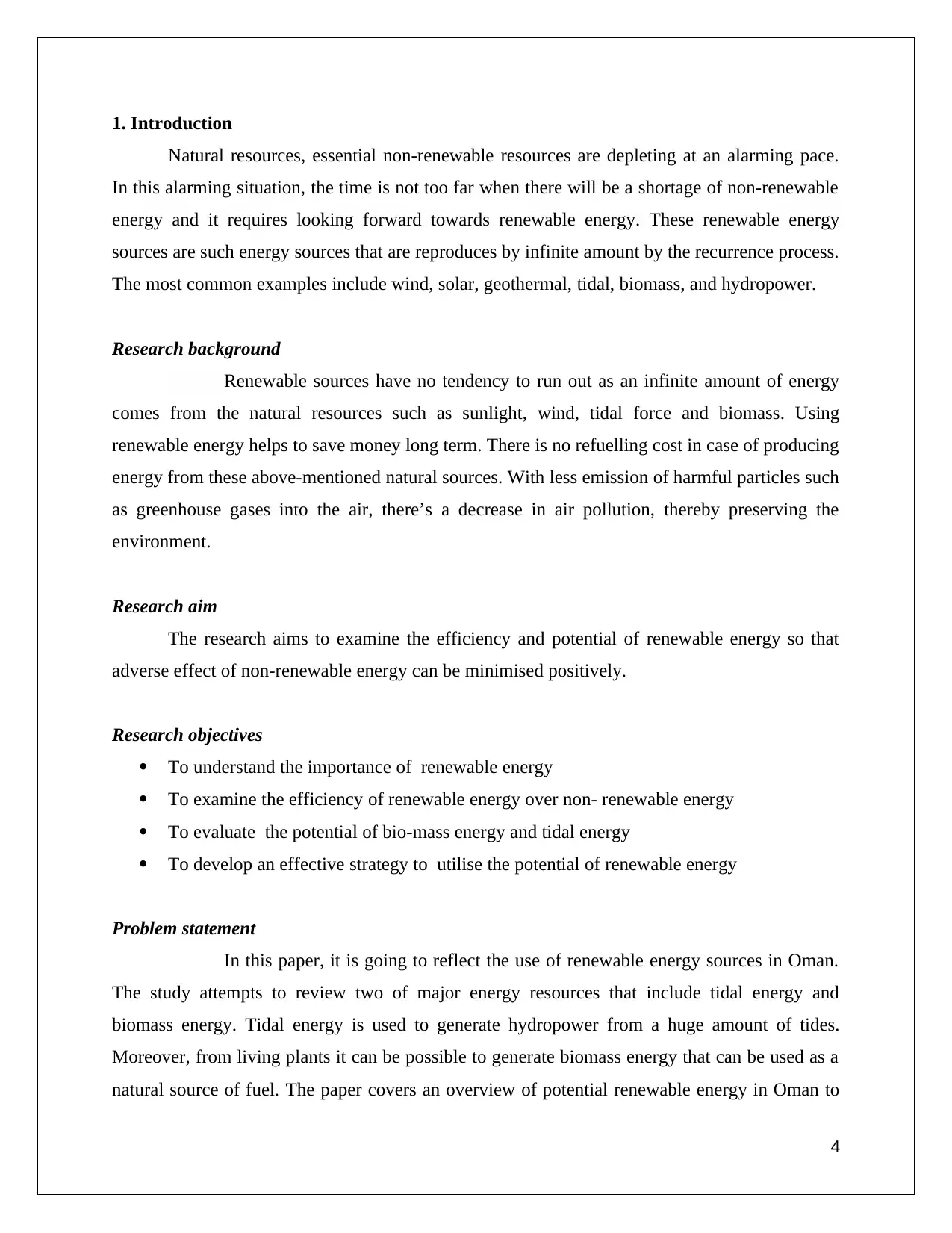
1. Introduction
Natural resources, essential non-renewable resources are depleting at an alarming pace.
In this alarming situation, the time is not too far when there will be a shortage of non-renewable
energy and it requires looking forward towards renewable energy. These renewable energy
sources are such energy sources that are reproduces by infinite amount by the recurrence process.
The most common examples include wind, solar, geothermal, tidal, biomass, and hydropower.
Research background
Renewable sources have no tendency to run out as an infinite amount of energy
comes from the natural resources such as sunlight, wind, tidal force and biomass. Using
renewable energy helps to save money long term. There is no refuelling cost in case of producing
energy from these above-mentioned natural sources. With less emission of harmful particles such
as greenhouse gases into the air, there’s a decrease in air pollution, thereby preserving the
environment.
Research aim
The research aims to examine the efficiency and potential of renewable energy so that
adverse effect of non-renewable energy can be minimised positively.
Research objectives
To understand the importance of renewable energy
To examine the efficiency of renewable energy over non- renewable energy
To evaluate the potential of bio-mass energy and tidal energy
To develop an effective strategy to utilise the potential of renewable energy
Problem statement
In this paper, it is going to reflect the use of renewable energy sources in Oman.
The study attempts to review two of major energy resources that include tidal energy and
biomass energy. Tidal energy is used to generate hydropower from a huge amount of tides.
Moreover, from living plants it can be possible to generate biomass energy that can be used as a
natural source of fuel. The paper covers an overview of potential renewable energy in Oman to
4
Natural resources, essential non-renewable resources are depleting at an alarming pace.
In this alarming situation, the time is not too far when there will be a shortage of non-renewable
energy and it requires looking forward towards renewable energy. These renewable energy
sources are such energy sources that are reproduces by infinite amount by the recurrence process.
The most common examples include wind, solar, geothermal, tidal, biomass, and hydropower.
Research background
Renewable sources have no tendency to run out as an infinite amount of energy
comes from the natural resources such as sunlight, wind, tidal force and biomass. Using
renewable energy helps to save money long term. There is no refuelling cost in case of producing
energy from these above-mentioned natural sources. With less emission of harmful particles such
as greenhouse gases into the air, there’s a decrease in air pollution, thereby preserving the
environment.
Research aim
The research aims to examine the efficiency and potential of renewable energy so that
adverse effect of non-renewable energy can be minimised positively.
Research objectives
To understand the importance of renewable energy
To examine the efficiency of renewable energy over non- renewable energy
To evaluate the potential of bio-mass energy and tidal energy
To develop an effective strategy to utilise the potential of renewable energy
Problem statement
In this paper, it is going to reflect the use of renewable energy sources in Oman.
The study attempts to review two of major energy resources that include tidal energy and
biomass energy. Tidal energy is used to generate hydropower from a huge amount of tides.
Moreover, from living plants it can be possible to generate biomass energy that can be used as a
natural source of fuel. The paper covers an overview of potential renewable energy in Oman to
4
Paraphrase This Document
Need a fresh take? Get an instant paraphrase of this document with our AI Paraphraser
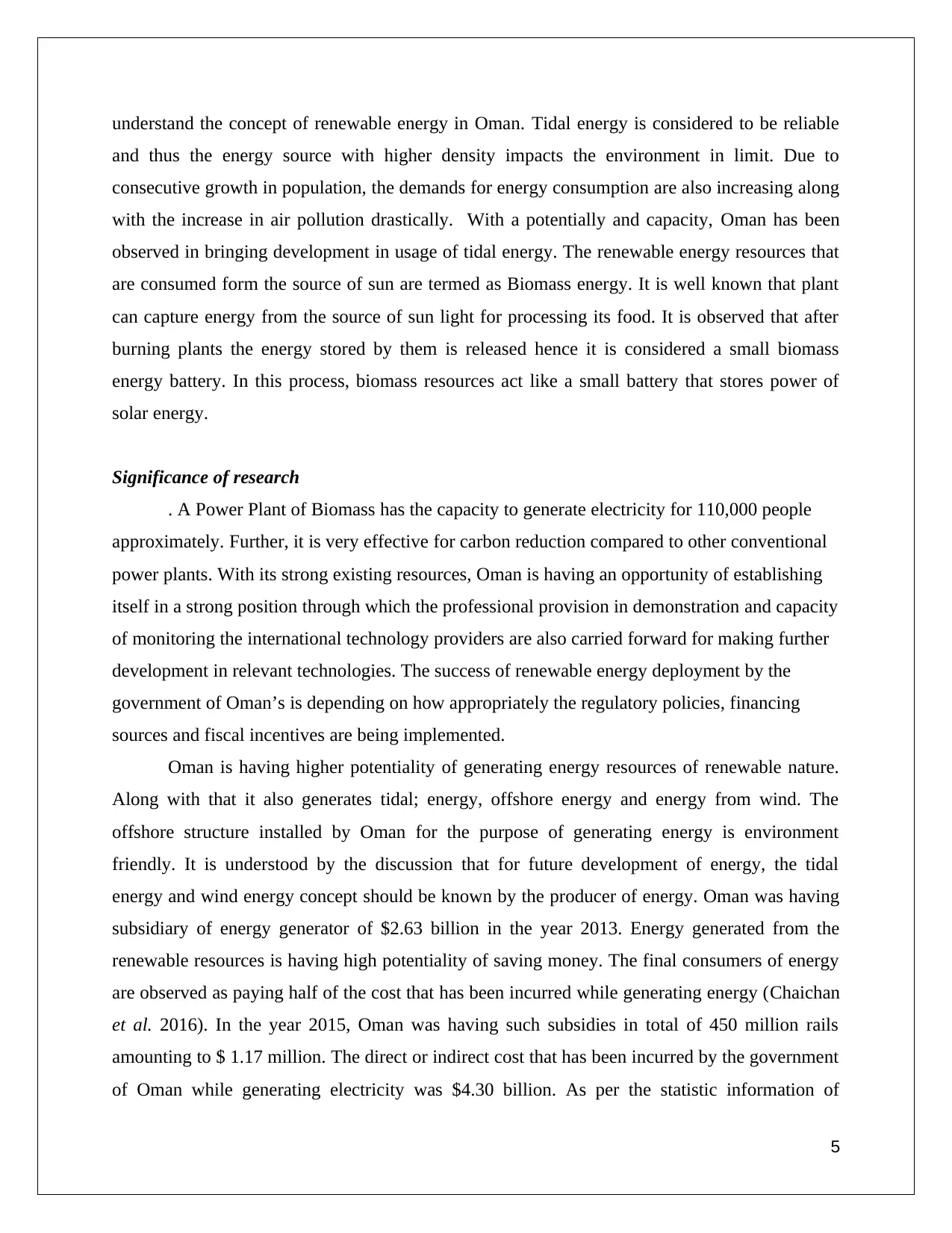
understand the concept of renewable energy in Oman. Tidal energy is considered to be reliable
and thus the energy source with higher density impacts the environment in limit. Due to
consecutive growth in population, the demands for energy consumption are also increasing along
with the increase in air pollution drastically. With a potentially and capacity, Oman has been
observed in bringing development in usage of tidal energy. The renewable energy resources that
are consumed form the source of sun are termed as Biomass energy. It is well known that plant
can capture energy from the source of sun light for processing its food. It is observed that after
burning plants the energy stored by them is released hence it is considered a small biomass
energy battery. In this process, biomass resources act like a small battery that stores power of
solar energy.
Significance of research
. A Power Plant of Biomass has the capacity to generate electricity for 110,000 people
approximately. Further, it is very effective for carbon reduction compared to other conventional
power plants. With its strong existing resources, Oman is having an opportunity of establishing
itself in a strong position through which the professional provision in demonstration and capacity
of monitoring the international technology providers are also carried forward for making further
development in relevant technologies. The success of renewable energy deployment by the
government of Oman’s is depending on how appropriately the regulatory policies, financing
sources and fiscal incentives are being implemented.
Oman is having higher potentiality of generating energy resources of renewable nature.
Along with that it also generates tidal; energy, offshore energy and energy from wind. The
offshore structure installed by Oman for the purpose of generating energy is environment
friendly. It is understood by the discussion that for future development of energy, the tidal
energy and wind energy concept should be known by the producer of energy. Oman was having
subsidiary of energy generator of $2.63 billion in the year 2013. Energy generated from the
renewable resources is having high potentiality of saving money. The final consumers of energy
are observed as paying half of the cost that has been incurred while generating energy (Chaichan
et al. 2016). In the year 2015, Oman was having such subsidies in total of 450 million rails
amounting to $ 1.17 million. The direct or indirect cost that has been incurred by the government
of Oman while generating electricity was $4.30 billion. As per the statistic information of
5
and thus the energy source with higher density impacts the environment in limit. Due to
consecutive growth in population, the demands for energy consumption are also increasing along
with the increase in air pollution drastically. With a potentially and capacity, Oman has been
observed in bringing development in usage of tidal energy. The renewable energy resources that
are consumed form the source of sun are termed as Biomass energy. It is well known that plant
can capture energy from the source of sun light for processing its food. It is observed that after
burning plants the energy stored by them is released hence it is considered a small biomass
energy battery. In this process, biomass resources act like a small battery that stores power of
solar energy.
Significance of research
. A Power Plant of Biomass has the capacity to generate electricity for 110,000 people
approximately. Further, it is very effective for carbon reduction compared to other conventional
power plants. With its strong existing resources, Oman is having an opportunity of establishing
itself in a strong position through which the professional provision in demonstration and capacity
of monitoring the international technology providers are also carried forward for making further
development in relevant technologies. The success of renewable energy deployment by the
government of Oman’s is depending on how appropriately the regulatory policies, financing
sources and fiscal incentives are being implemented.
Oman is having higher potentiality of generating energy resources of renewable nature.
Along with that it also generates tidal; energy, offshore energy and energy from wind. The
offshore structure installed by Oman for the purpose of generating energy is environment
friendly. It is understood by the discussion that for future development of energy, the tidal
energy and wind energy concept should be known by the producer of energy. Oman was having
subsidiary of energy generator of $2.63 billion in the year 2013. Energy generated from the
renewable resources is having high potentiality of saving money. The final consumers of energy
are observed as paying half of the cost that has been incurred while generating energy (Chaichan
et al. 2016). In the year 2015, Oman was having such subsidies in total of 450 million rails
amounting to $ 1.17 million. The direct or indirect cost that has been incurred by the government
of Oman while generating electricity was $4.30 billion. As per the statistic information of
5
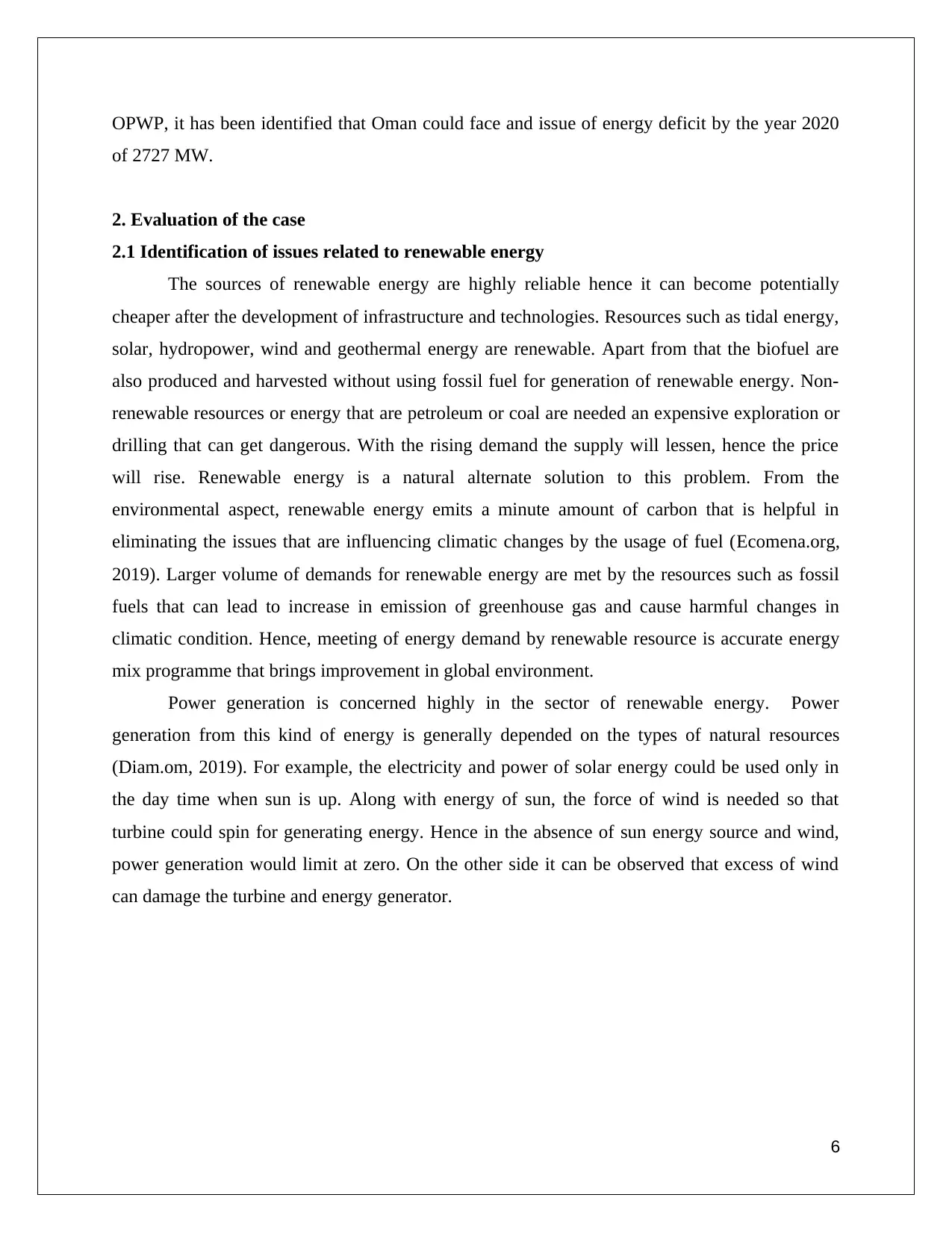
OPWP, it has been identified that Oman could face and issue of energy deficit by the year 2020
of 2727 MW.
2. Evaluation of the case
2.1 Identification of issues related to renewable energy
The sources of renewable energy are highly reliable hence it can become potentially
cheaper after the development of infrastructure and technologies. Resources such as tidal energy,
solar, hydropower, wind and geothermal energy are renewable. Apart from that the biofuel are
also produced and harvested without using fossil fuel for generation of renewable energy. Non-
renewable resources or energy that are petroleum or coal are needed an expensive exploration or
drilling that can get dangerous. With the rising demand the supply will lessen, hence the price
will rise. Renewable energy is a natural alternate solution to this problem. From the
environmental aspect, renewable energy emits a minute amount of carbon that is helpful in
eliminating the issues that are influencing climatic changes by the usage of fuel (Ecomena.org,
2019). Larger volume of demands for renewable energy are met by the resources such as fossil
fuels that can lead to increase in emission of greenhouse gas and cause harmful changes in
climatic condition. Hence, meeting of energy demand by renewable resource is accurate energy
mix programme that brings improvement in global environment.
Power generation is concerned highly in the sector of renewable energy. Power
generation from this kind of energy is generally depended on the types of natural resources
(Diam.om, 2019). For example, the electricity and power of solar energy could be used only in
the day time when sun is up. Along with energy of sun, the force of wind is needed so that
turbine could spin for generating energy. Hence in the absence of sun energy source and wind,
power generation would limit at zero. On the other side it can be observed that excess of wind
can damage the turbine and energy generator.
6
of 2727 MW.
2. Evaluation of the case
2.1 Identification of issues related to renewable energy
The sources of renewable energy are highly reliable hence it can become potentially
cheaper after the development of infrastructure and technologies. Resources such as tidal energy,
solar, hydropower, wind and geothermal energy are renewable. Apart from that the biofuel are
also produced and harvested without using fossil fuel for generation of renewable energy. Non-
renewable resources or energy that are petroleum or coal are needed an expensive exploration or
drilling that can get dangerous. With the rising demand the supply will lessen, hence the price
will rise. Renewable energy is a natural alternate solution to this problem. From the
environmental aspect, renewable energy emits a minute amount of carbon that is helpful in
eliminating the issues that are influencing climatic changes by the usage of fuel (Ecomena.org,
2019). Larger volume of demands for renewable energy are met by the resources such as fossil
fuels that can lead to increase in emission of greenhouse gas and cause harmful changes in
climatic condition. Hence, meeting of energy demand by renewable resource is accurate energy
mix programme that brings improvement in global environment.
Power generation is concerned highly in the sector of renewable energy. Power
generation from this kind of energy is generally depended on the types of natural resources
(Diam.om, 2019). For example, the electricity and power of solar energy could be used only in
the day time when sun is up. Along with energy of sun, the force of wind is needed so that
turbine could spin for generating energy. Hence in the absence of sun energy source and wind,
power generation would limit at zero. On the other side it can be observed that excess of wind
can damage the turbine and energy generator.
6
⊘ This is a preview!⊘
Do you want full access?
Subscribe today to unlock all pages.

Trusted by 1+ million students worldwide
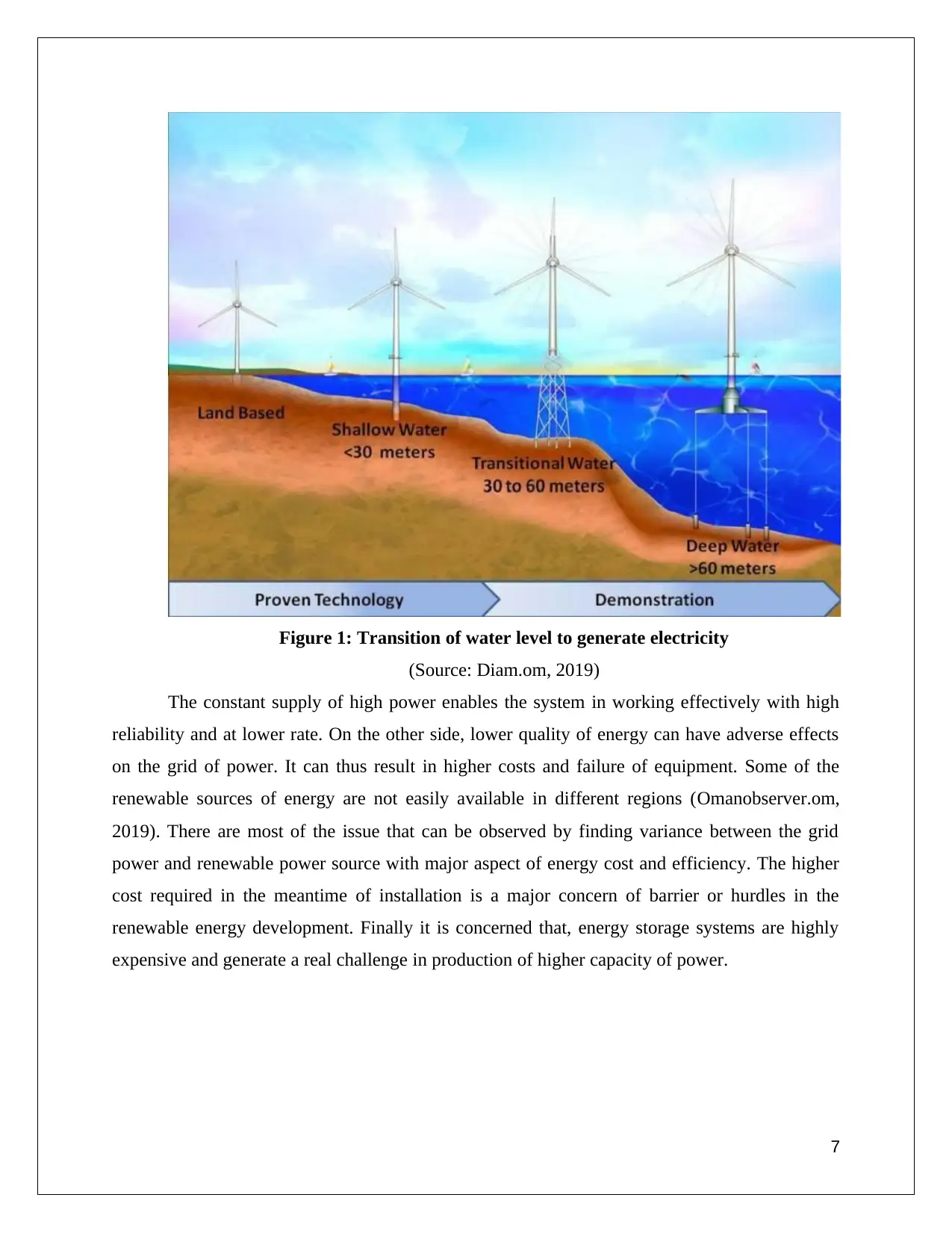
Figure 1: Transition of water level to generate electricity
(Source: Diam.om, 2019)
The constant supply of high power enables the system in working effectively with high
reliability and at lower rate. On the other side, lower quality of energy can have adverse effects
on the grid of power. It can thus result in higher costs and failure of equipment. Some of the
renewable sources of energy are not easily available in different regions (Omanobserver.om,
2019). There are most of the issue that can be observed by finding variance between the grid
power and renewable power source with major aspect of energy cost and efficiency. The higher
cost required in the meantime of installation is a major concern of barrier or hurdles in the
renewable energy development. Finally it is concerned that, energy storage systems are highly
expensive and generate a real challenge in production of higher capacity of power.
7
(Source: Diam.om, 2019)
The constant supply of high power enables the system in working effectively with high
reliability and at lower rate. On the other side, lower quality of energy can have adverse effects
on the grid of power. It can thus result in higher costs and failure of equipment. Some of the
renewable sources of energy are not easily available in different regions (Omanobserver.om,
2019). There are most of the issue that can be observed by finding variance between the grid
power and renewable power source with major aspect of energy cost and efficiency. The higher
cost required in the meantime of installation is a major concern of barrier or hurdles in the
renewable energy development. Finally it is concerned that, energy storage systems are highly
expensive and generate a real challenge in production of higher capacity of power.
7
Paraphrase This Document
Need a fresh take? Get an instant paraphrase of this document with our AI Paraphraser
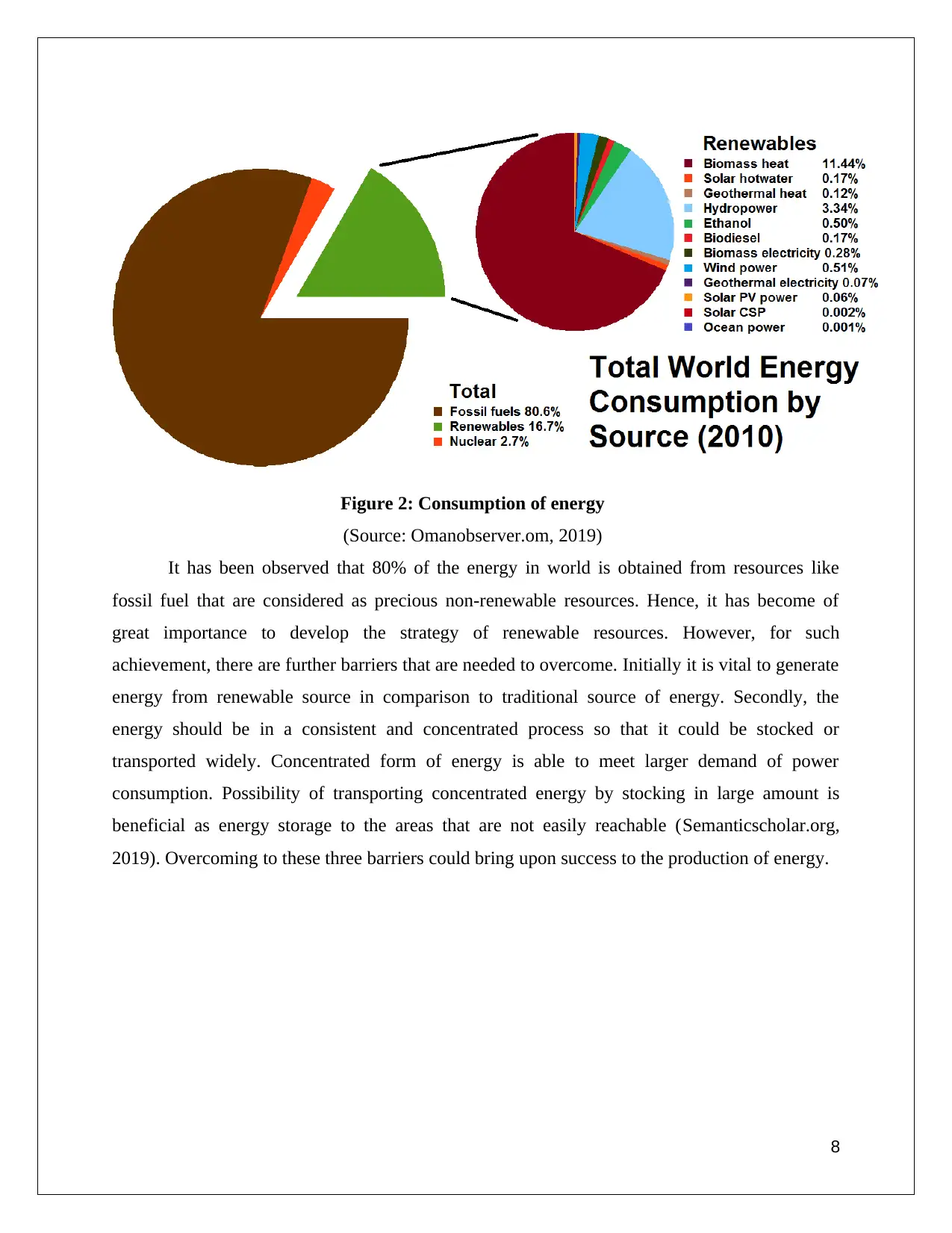
Figure 2: Consumption of energy
(Source: Omanobserver.om, 2019)
It has been observed that 80% of the energy in world is obtained from resources like
fossil fuel that are considered as precious non-renewable resources. Hence, it has become of
great importance to develop the strategy of renewable resources. However, for such
achievement, there are further barriers that are needed to overcome. Initially it is vital to generate
energy from renewable source in comparison to traditional source of energy. Secondly, the
energy should be in a consistent and concentrated process so that it could be stocked or
transported widely. Concentrated form of energy is able to meet larger demand of power
consumption. Possibility of transporting concentrated energy by stocking in large amount is
beneficial as energy storage to the areas that are not easily reachable (Semanticscholar.org,
2019). Overcoming to these three barriers could bring upon success to the production of energy.
8
(Source: Omanobserver.om, 2019)
It has been observed that 80% of the energy in world is obtained from resources like
fossil fuel that are considered as precious non-renewable resources. Hence, it has become of
great importance to develop the strategy of renewable resources. However, for such
achievement, there are further barriers that are needed to overcome. Initially it is vital to generate
energy from renewable source in comparison to traditional source of energy. Secondly, the
energy should be in a consistent and concentrated process so that it could be stocked or
transported widely. Concentrated form of energy is able to meet larger demand of power
consumption. Possibility of transporting concentrated energy by stocking in large amount is
beneficial as energy storage to the areas that are not easily reachable (Semanticscholar.org,
2019). Overcoming to these three barriers could bring upon success to the production of energy.
8
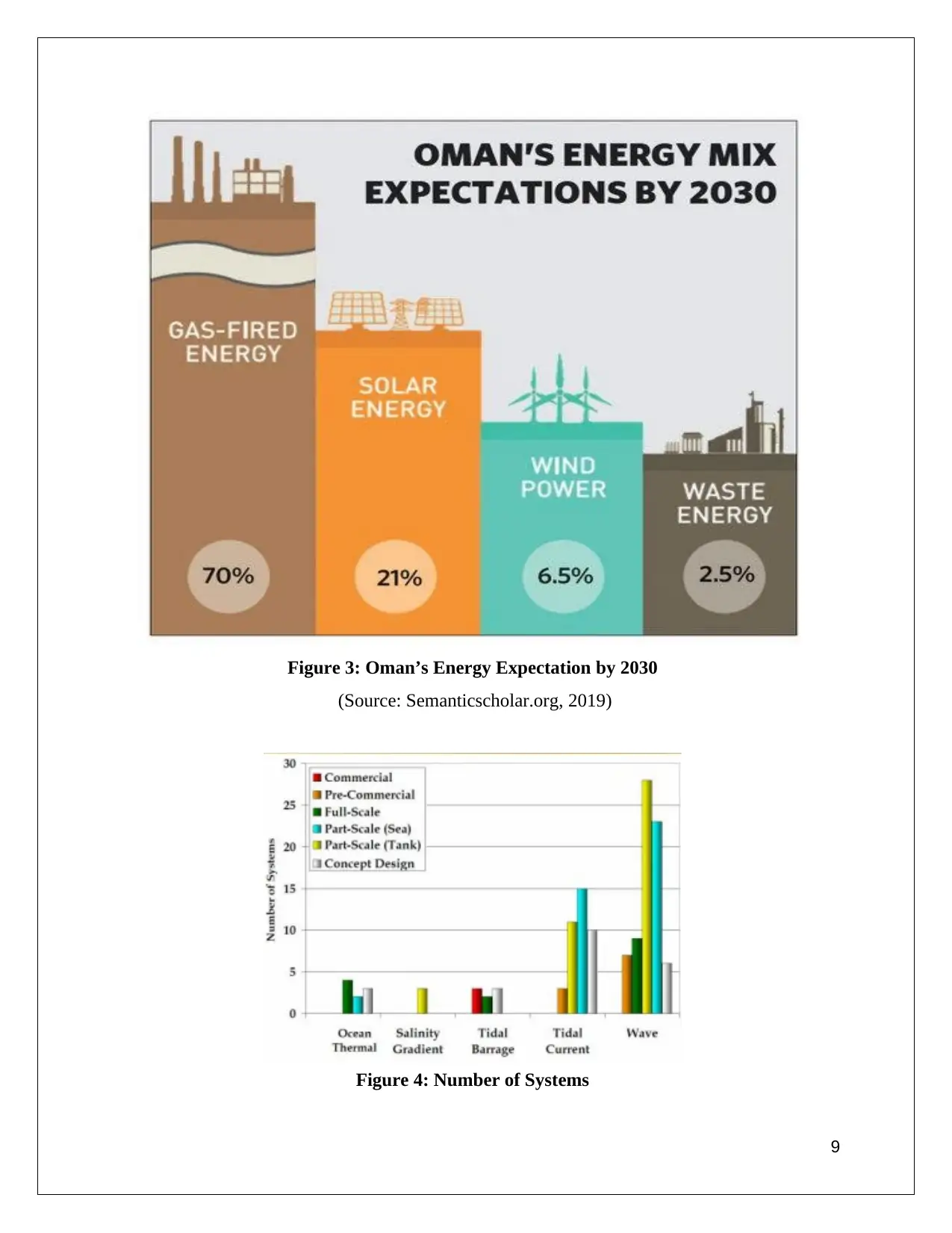
Figure 3: Oman’s Energy Expectation by 2030
(Source: Semanticscholar.org, 2019)
Figure 4: Number of Systems
9
(Source: Semanticscholar.org, 2019)
Figure 4: Number of Systems
9
⊘ This is a preview!⊘
Do you want full access?
Subscribe today to unlock all pages.

Trusted by 1+ million students worldwide
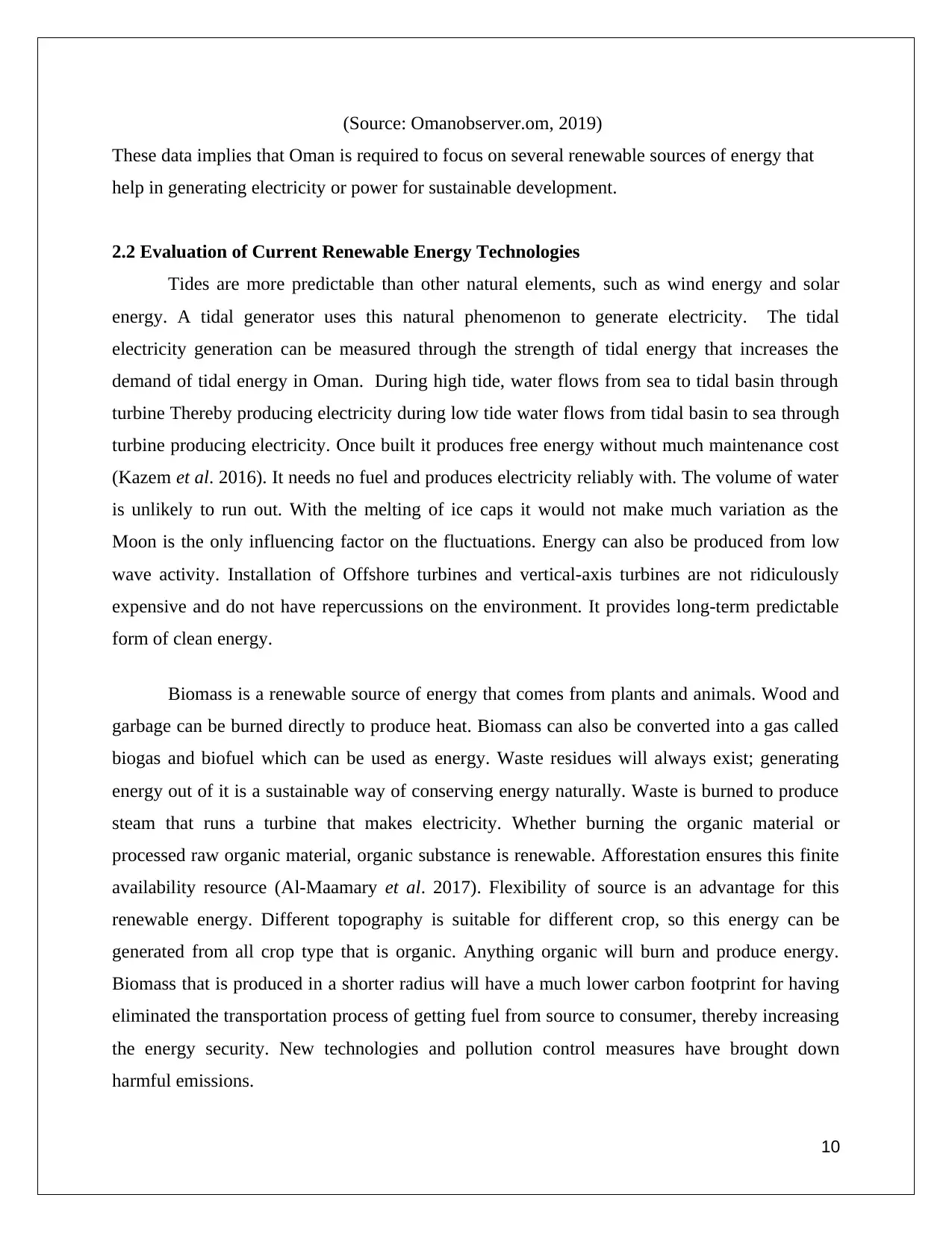
(Source: Omanobserver.om, 2019)
These data implies that Oman is required to focus on several renewable sources of energy that
help in generating electricity or power for sustainable development.
2.2 Evaluation of Current Renewable Energy Technologies
Tides are more predictable than other natural elements, such as wind energy and solar
energy. A tidal generator uses this natural phenomenon to generate electricity. The tidal
electricity generation can be measured through the strength of tidal energy that increases the
demand of tidal energy in Oman. During high tide, water flows from sea to tidal basin through
turbine Thereby producing electricity during low tide water flows from tidal basin to sea through
turbine producing electricity. Once built it produces free energy without much maintenance cost
(Kazem et al. 2016). It needs no fuel and produces electricity reliably with. The volume of water
is unlikely to run out. With the melting of ice caps it would not make much variation as the
Moon is the only influencing factor on the fluctuations. Energy can also be produced from low
wave activity. Installation of Offshore turbines and vertical-axis turbines are not ridiculously
expensive and do not have repercussions on the environment. It provides long-term predictable
form of clean energy.
Biomass is a renewable source of energy that comes from plants and animals. Wood and
garbage can be burned directly to produce heat. Biomass can also be converted into a gas called
biogas and biofuel which can be used as energy. Waste residues will always exist; generating
energy out of it is a sustainable way of conserving energy naturally. Waste is burned to produce
steam that runs a turbine that makes electricity. Whether burning the organic material or
processed raw organic material, organic substance is renewable. Afforestation ensures this finite
availability resource (Al-Maamary et al. 2017). Flexibility of source is an advantage for this
renewable energy. Different topography is suitable for different crop, so this energy can be
generated from all crop type that is organic. Anything organic will burn and produce energy.
Biomass that is produced in a shorter radius will have a much lower carbon footprint for having
eliminated the transportation process of getting fuel from source to consumer, thereby increasing
the energy security. New technologies and pollution control measures have brought down
harmful emissions.
10
These data implies that Oman is required to focus on several renewable sources of energy that
help in generating electricity or power for sustainable development.
2.2 Evaluation of Current Renewable Energy Technologies
Tides are more predictable than other natural elements, such as wind energy and solar
energy. A tidal generator uses this natural phenomenon to generate electricity. The tidal
electricity generation can be measured through the strength of tidal energy that increases the
demand of tidal energy in Oman. During high tide, water flows from sea to tidal basin through
turbine Thereby producing electricity during low tide water flows from tidal basin to sea through
turbine producing electricity. Once built it produces free energy without much maintenance cost
(Kazem et al. 2016). It needs no fuel and produces electricity reliably with. The volume of water
is unlikely to run out. With the melting of ice caps it would not make much variation as the
Moon is the only influencing factor on the fluctuations. Energy can also be produced from low
wave activity. Installation of Offshore turbines and vertical-axis turbines are not ridiculously
expensive and do not have repercussions on the environment. It provides long-term predictable
form of clean energy.
Biomass is a renewable source of energy that comes from plants and animals. Wood and
garbage can be burned directly to produce heat. Biomass can also be converted into a gas called
biogas and biofuel which can be used as energy. Waste residues will always exist; generating
energy out of it is a sustainable way of conserving energy naturally. Waste is burned to produce
steam that runs a turbine that makes electricity. Whether burning the organic material or
processed raw organic material, organic substance is renewable. Afforestation ensures this finite
availability resource (Al-Maamary et al. 2017). Flexibility of source is an advantage for this
renewable energy. Different topography is suitable for different crop, so this energy can be
generated from all crop type that is organic. Anything organic will burn and produce energy.
Biomass that is produced in a shorter radius will have a much lower carbon footprint for having
eliminated the transportation process of getting fuel from source to consumer, thereby increasing
the energy security. New technologies and pollution control measures have brought down
harmful emissions.
10
Paraphrase This Document
Need a fresh take? Get an instant paraphrase of this document with our AI Paraphraser
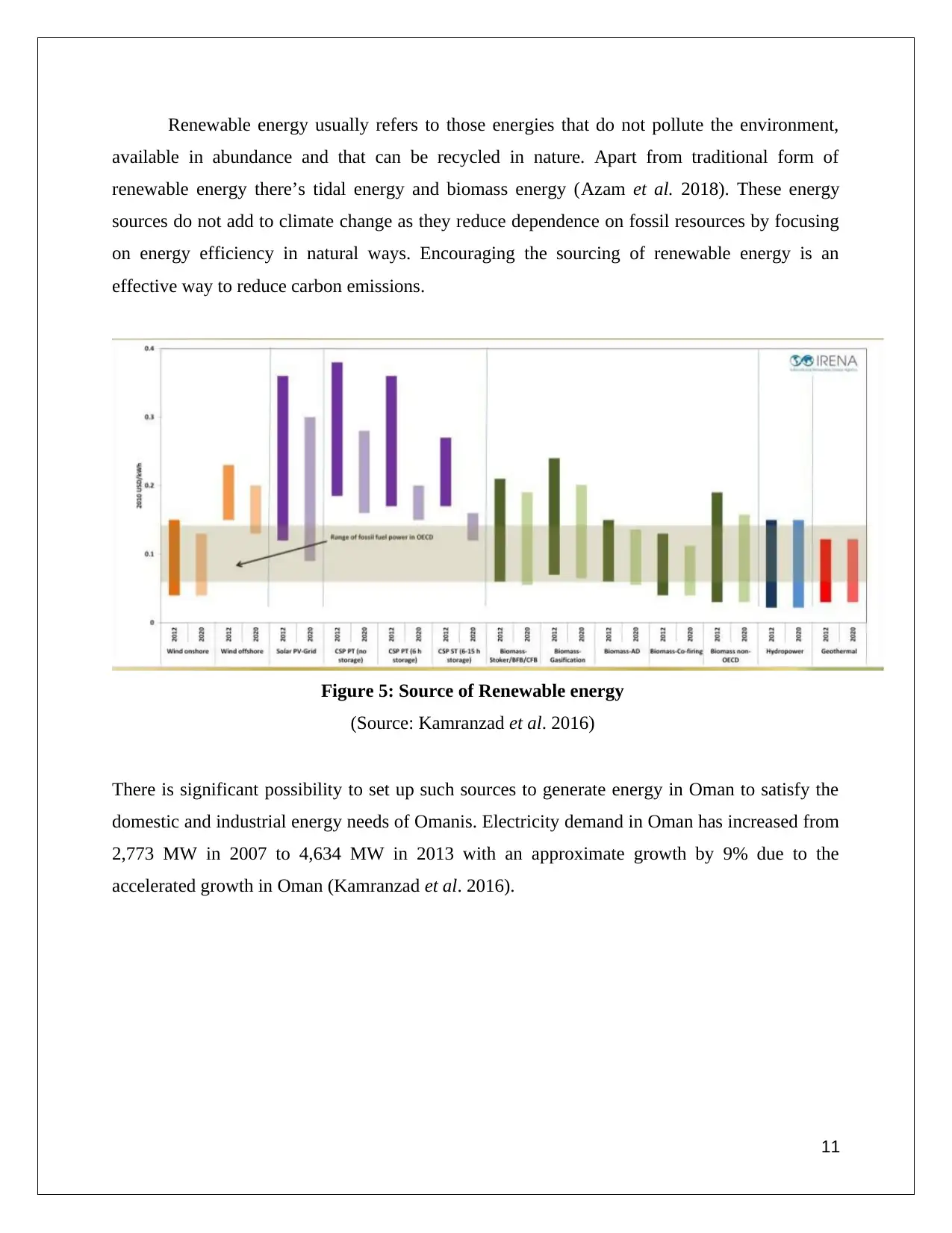
Renewable energy usually refers to those energies that do not pollute the environment,
available in abundance and that can be recycled in nature. Apart from traditional form of
renewable energy there’s tidal energy and biomass energy (Azam et al. 2018). These energy
sources do not add to climate change as they reduce dependence on fossil resources by focusing
on energy efficiency in natural ways. Encouraging the sourcing of renewable energy is an
effective way to reduce carbon emissions.
Figure 5: Source of Renewable energy
(Source: Kamranzad et al. 2016)
There is significant possibility to set up such sources to generate energy in Oman to satisfy the
domestic and industrial energy needs of Omanis. Electricity demand in Oman has increased from
2,773 MW in 2007 to 4,634 MW in 2013 with an approximate growth by 9% due to the
accelerated growth in Oman (Kamranzad et al. 2016).
11
available in abundance and that can be recycled in nature. Apart from traditional form of
renewable energy there’s tidal energy and biomass energy (Azam et al. 2018). These energy
sources do not add to climate change as they reduce dependence on fossil resources by focusing
on energy efficiency in natural ways. Encouraging the sourcing of renewable energy is an
effective way to reduce carbon emissions.
Figure 5: Source of Renewable energy
(Source: Kamranzad et al. 2016)
There is significant possibility to set up such sources to generate energy in Oman to satisfy the
domestic and industrial energy needs of Omanis. Electricity demand in Oman has increased from
2,773 MW in 2007 to 4,634 MW in 2013 with an approximate growth by 9% due to the
accelerated growth in Oman (Kamranzad et al. 2016).
11
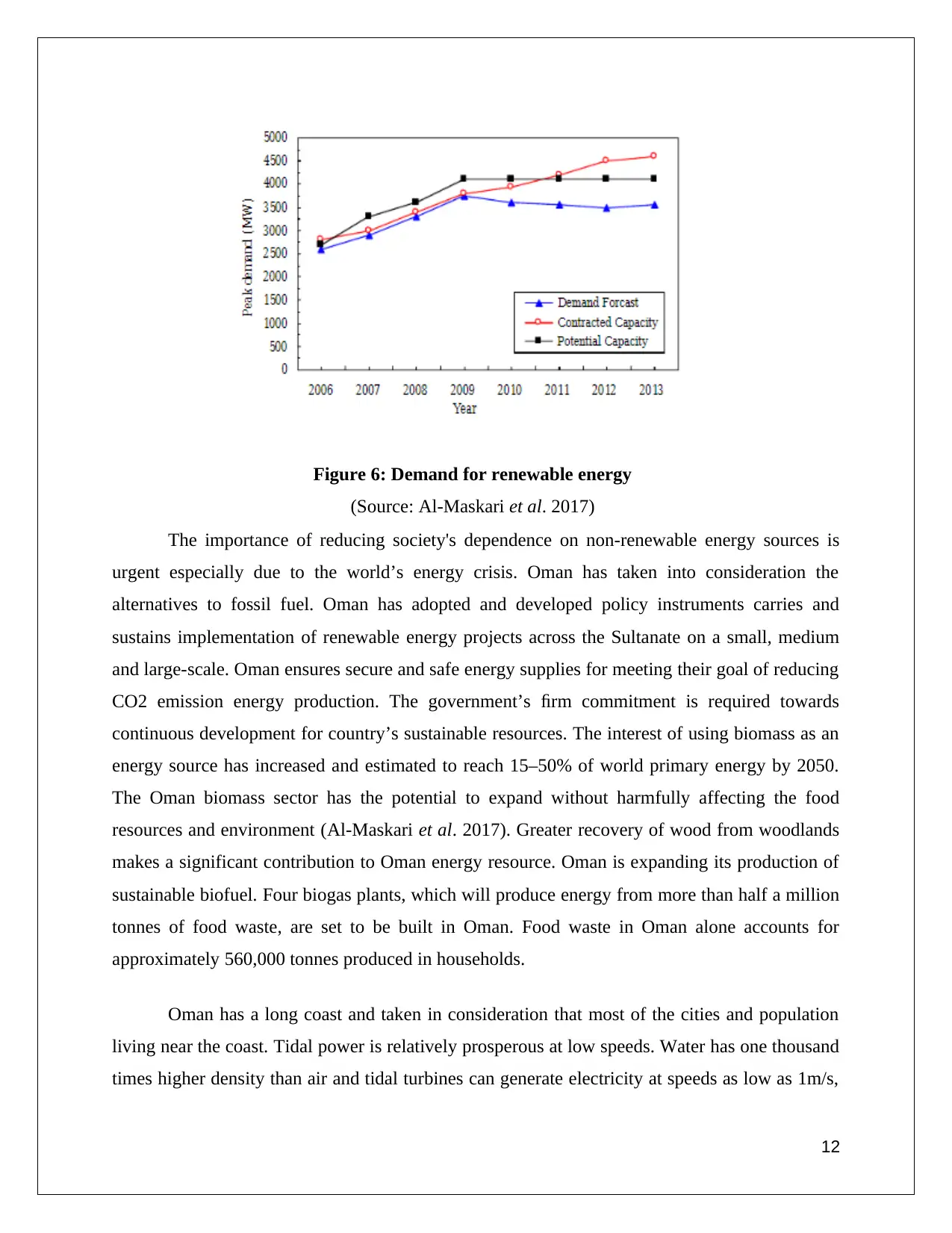
Figure 6: Demand for renewable energy
(Source: Al-Maskari et al. 2017)
The importance of reducing society's dependence on non-renewable energy sources is
urgent especially due to the world’s energy crisis. Oman has taken into consideration the
alternatives to fossil fuel. Oman has adopted and developed policy instruments carries and
sustains implementation of renewable energy projects across the Sultanate on a small, medium
and large-scale. Oman ensures secure and safe energy supplies for meeting their goal of reducing
CO2 emission energy production. The government’s firm commitment is required towards
continuous development for country’s sustainable resources. The interest of using biomass as an
energy source has increased and estimated to reach 15–50% of world primary energy by 2050.
The Oman biomass sector has the potential to expand without harmfully affecting the food
resources and environment (Al-Maskari et al. 2017). Greater recovery of wood from woodlands
makes a significant contribution to Oman energy resource. Oman is expanding its production of
sustainable biofuel. Four biogas plants, which will produce energy from more than half a million
tonnes of food waste, are set to be built in Oman. Food waste in Oman alone accounts for
approximately 560,000 tonnes produced in households.
Oman has a long coast and taken in consideration that most of the cities and population
living near the coast. Tidal power is relatively prosperous at low speeds. Water has one thousand
times higher density than air and tidal turbines can generate electricity at speeds as low as 1m/s,
12
(Source: Al-Maskari et al. 2017)
The importance of reducing society's dependence on non-renewable energy sources is
urgent especially due to the world’s energy crisis. Oman has taken into consideration the
alternatives to fossil fuel. Oman has adopted and developed policy instruments carries and
sustains implementation of renewable energy projects across the Sultanate on a small, medium
and large-scale. Oman ensures secure and safe energy supplies for meeting their goal of reducing
CO2 emission energy production. The government’s firm commitment is required towards
continuous development for country’s sustainable resources. The interest of using biomass as an
energy source has increased and estimated to reach 15–50% of world primary energy by 2050.
The Oman biomass sector has the potential to expand without harmfully affecting the food
resources and environment (Al-Maskari et al. 2017). Greater recovery of wood from woodlands
makes a significant contribution to Oman energy resource. Oman is expanding its production of
sustainable biofuel. Four biogas plants, which will produce energy from more than half a million
tonnes of food waste, are set to be built in Oman. Food waste in Oman alone accounts for
approximately 560,000 tonnes produced in households.
Oman has a long coast and taken in consideration that most of the cities and population
living near the coast. Tidal power is relatively prosperous at low speeds. Water has one thousand
times higher density than air and tidal turbines can generate electricity at speeds as low as 1m/s,
12
⊘ This is a preview!⊘
Do you want full access?
Subscribe today to unlock all pages.

Trusted by 1+ million students worldwide
1 out of 20
Related Documents
Your All-in-One AI-Powered Toolkit for Academic Success.
+13062052269
info@desklib.com
Available 24*7 on WhatsApp / Email
![[object Object]](/_next/static/media/star-bottom.7253800d.svg)
Unlock your academic potential
Copyright © 2020–2025 A2Z Services. All Rights Reserved. Developed and managed by ZUCOL.





